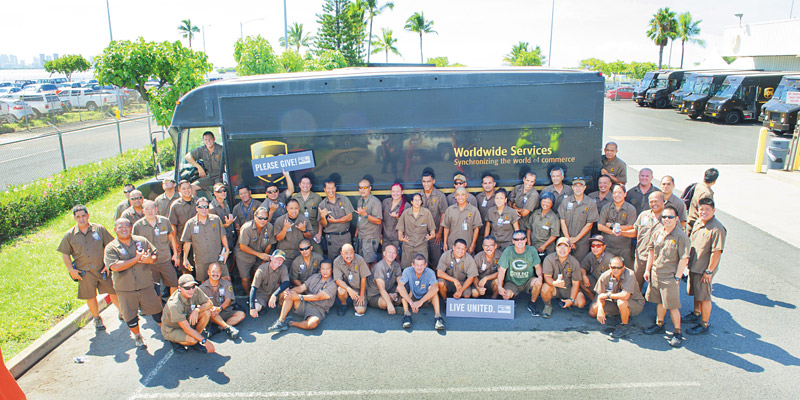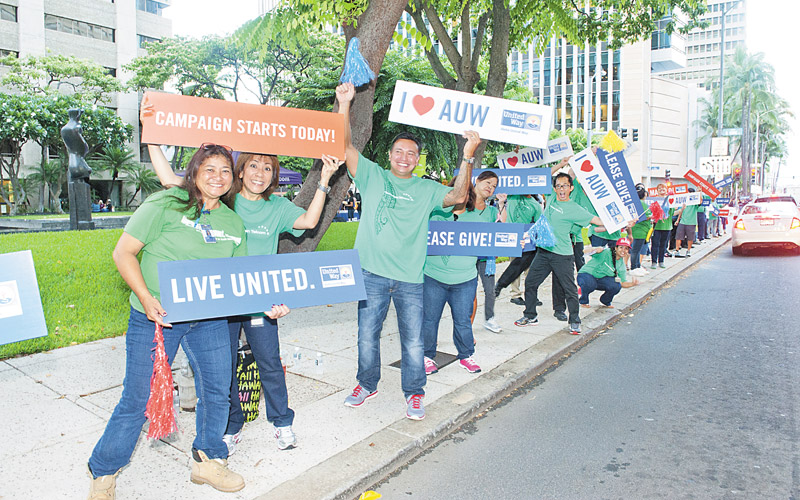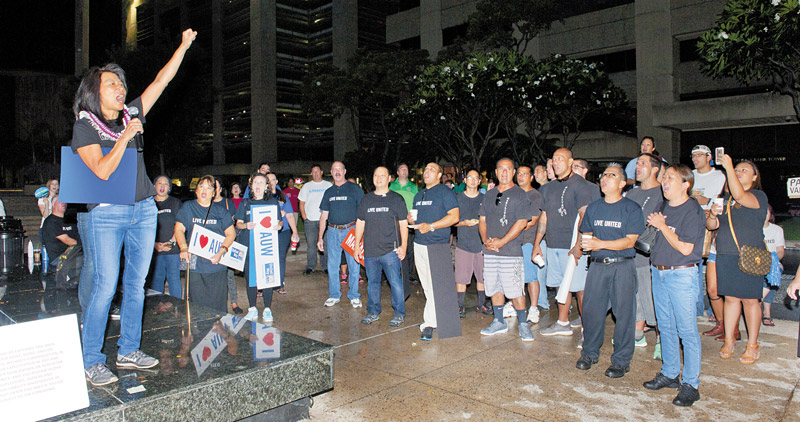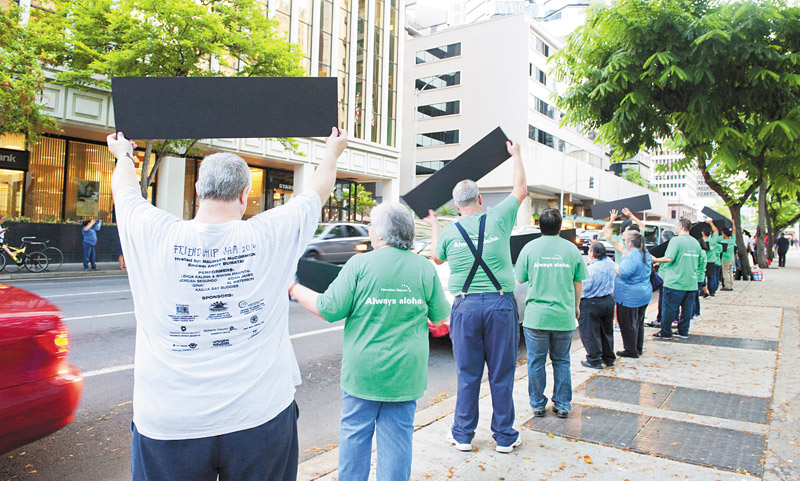Getting Results
The best thing about donating to Aloha United Way, say Thomas Kiyabu, this year’s campaign chairman and head of UPS in Hawaii, and AUW president Cindy Adams, is that you can be assured your dollars will bring about a positive result for someone in need
When you look to your future, how do you view it?
If you are like most people, according to a study by Harvard psychology professor Dan Gilbert, you look forward to a bright future with positive results despite having a history of ups and downs. This is called an error of prospection.
But the future will have dark clouds, illnesses and struggles, and even if you can avoid those, we all know how our story ends.
In Hawaii, one of four families require some sort of financial assistance, and of the remaining families, one of every three has insufficient reserves to even survive 90 days, if their incomes are interrupted.
Now, look out your window. Can you see three houses? Of course you can. If you are like most of us, you can see dozens. Realizing that a third of those families are that close to being homeless makes the needs pressing and the work that Aloha United Way does all the more immediate.
“We are such a small community, and there aren’t too many cases where a family has not had the need for some kind of social service,” says AUW president Cindy Adams. “Whether it be Hospice Hawaii or Easter Seals or the food bank, and even if it wasn’t your family, it was a neighbor or an auntie or a cousin, there aren’t too many degrees of separation in Hawaii in how the nonprofits support the community as a whole. That is why so many people here give back.”
AUW funds 342 nonprofits in this state, covering needs from the cradle to the grave, with most of its money coming from workplace donations that come straight out of workers’ paychecks and can either go directly to the charity the worker chooses or to a designated area, like education or poverty prevention.
Fronting the campaign to raise participation in the workplace-donation program is Thomas Kiyabu, UPS Hawaii division manager. He is a natural choice, as UPS has been a supporter of AUW dating back to 1982, and is the only company worldwide to have broken the $1 billion mark in donations to United Way.
“Our people know where their hard-earned money is going to, and as people understand that, more and more is given,” says Thomas, noting that last year 90 percent of his employees made donations. “That is remarkable because you have people who won’t give at all, but we have reached their hearts where they gave. We make 19,000 stops a day. Our drivers hear the stories from our customers, they see the environment and they see what is happening and share it with us, and they understand the sadness of what is going on.”
UPS has come up with a variety of programs to raise funds, from Dunk-the-Boss tanks to Jeans Fridays, where executives can dress casually if they make a donation pledge. Along with raising funds for AUW, the programs also boost morale.
“When employees are happy, profits comes along. They come to work and work hard, protect the brand — they are very efficient at what they do,” says Kiyabu. “If you give an employee an opportunity to decide what they want to do with the funding, it strengthens the brand and attracts younger workers who really like to give back.”
Adams sees the actions by Kiyabu and his workers as the biggest selling point to why other companies will join in the campaign.
“How do you bring more companies into the program?” asks Adams. “It is by setting the example like Thomas is doing. Not only can he introduce other companies to Aloha United Way, but also people can see their participation and that it is OK for other companies to do that as well.”
While there is a quantitative goal for this year’s campaign — $9.7 million — the intent under Adams’ leadership is to shift the focus to the good accomplished rather than dollars raised.
“What is the impact that donor funds are having in the community?” queries Adams. “There are three areas that we are focused on: education, poverty prevention, and crisis intervention or safety-net services. While, historically, we have focused more on the financial goal, this year we are talking about what are the differences these donations are making in the lives that need these services.”
Oftentimes charities are about addressing the problems that are already here — Hawaii Foodbank feeding the hungry, Child & Family Service comforting the abused — and while there is a real need for that, AUW is splitting its contributions, with 40 percent going toward today’s needs and 60 percent toward eliminating future ones.
“Many nonprofits and donors are focused on crisis and intervention, but we are in a special position to be able to fund prevention because, if we don’t focus on prevention, then we will always have these very high downstream costs in social services. So we are very conscious of making an investment in prevention programs,” says Adams, citing as an example the high cost to society associated with teen pregnancies.
“There is a very high correlation between when a young lady gets pregnant before the age of 16 and the very high likelihood that she will end up on social services, and that it likely will be for an extended period of time. It is important to get in front of that.”
Prevention is a harder thing to put a number to. How does it show how many kids did not get pregnant because of its efforts? But to show donors what their dollars are doing, AUW has clearly laid out stats on its website, so you can see the work that is being done with your donation.
“It matters to donors to see the results, to see data, so now they feel like, ‘Man, I impacted four people’s lives’,” says Kiyabu. “It does matter, and it is important. Almost every person in Hawaii will give, whether it be chili tickets or Girl Scout cookies or something. So it is not just about ‘give money,’ but about educating people about where their money goes to, and that it really matters.”
When donations are not designated for a specific charity, they are used in a community outreach program that allows the nonprofits sorely needed unrestricted money for things like improving their infrastructure or buying the van they have needed. But it is not without oversight. It is a three-year program, this year involving $3.6 million, and the charities must provide a metric every six months of their progress and the outcomes they hope to achieve.
We often focus on these charities and social services as being only for the less fortunate, but Kiyabu got to experience firsthand the good they do, as his mother died this year after just reaching the century mark.
“Hospice Hawaii came into our lives, and we didn’t ask for anything,” says Kiyabu. “They came into the house and brought supplies, checked her out, and if it wasn’t for that she would not have lived to 100. When she passed, they came and told us what to do, and called to make sure everything is OK. It is amazing, they have a lot of passion, and it really made a difference.”
Just like Aloha United Way.










